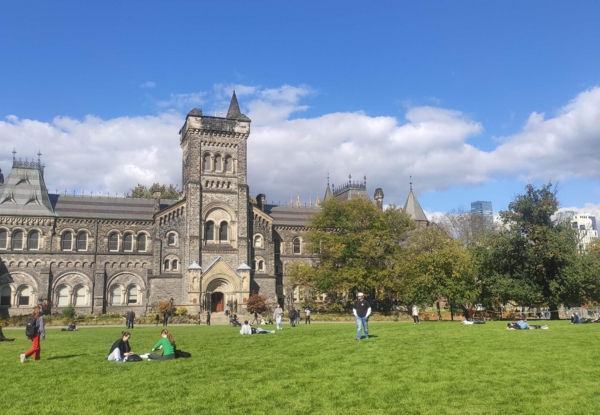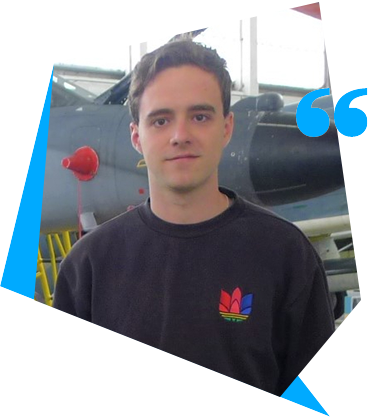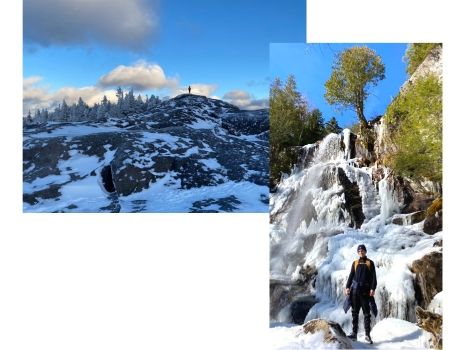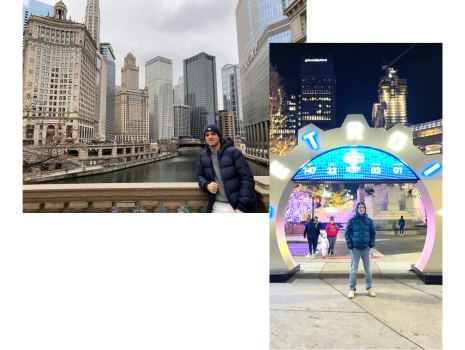< back to articles
4 months of substitution at the University of Toronto for Charles!
Published on
Charles took advantage of his substitution year to study for 4 months in Canada at the University of Toronto. The Foundation supported him through a substitution grant to enable him to make this trip. Charles looks back on a unique experience in North America!

This experience was an incredible opportunity. This 4-month substitution at the University of Toronto enabled me to discover many things: a new continent (I’d never been outside Europe before), a surprising new lifestyle, studies at a world-renowned university, magnificent landscapes and huge cities.
What motivated you to come to Canada?
Charles Millancourt

When I arrived at the University of Toronto at the end of August, I wanted to join a prestigious American university as an exchange student. My specific objective was to take courses related to my project and my passions: robotics, computer vision and seismology (with applications on the planet Mars). These courses were very intense and I had to put in a lot of work to catch up on certain aspects of robotics that I’d never seen before. Despite this, I really enjoyed the themes and came away with a wealth of knowledge. My passion for these aerospace engineering topics led me to take these courses, following my first internship at CNES (Centre National d’Etudes Spatiales), which was linked to 3D imaging for space exploration. Following on from this internship, I decided to take some theoretical courses to consolidate the knowledge I had acquired. The high quality courses given at the University of Toronto helped me understand the concepts, all in an incredible and unusual working environment. A beautiful old campus inspired by Gothic art, where classes are held in stained-glass classrooms. The St-George campus creates a working atmosphere I’ve never experienced before. All this motivated me throughout this substitution in a pleasant and studious environment.
Were there any particular courses that stood out for you?
the two robotics courses:
- Introduction to Robotics: this course was an introduction to the theoretical and practical aspects of robotics. Many aspects were covered, including robot types, navigation, map construction and localization. Alongside the lectures, practical sessions taught us how to use Linux interfaces to control robots and perform tasks such as locating ourselves on a topological map by associating probabilities. Numerous assignments, projects and tests have given me a global vision of robotics issues.
- Vision for Robotics: this course focuses specifically on the techniques used to navigate using cameras, and only cameras. Notions such as visual odometry, photogrammetry and deep learning are covered. It’s a very interesting and comprehensive course for people interested in autonomous cars or probe/rover navigation for space exploration.
And the University?
At university, I had access to many facilities reserved for students: an ice rink, sports halls, parks and libraries. All these spaces are XXL in size (like everything else in the city) and provide plenty of room for sporting and cultural activities. American college sports are very important, and many events revolve around them: American/European football, field hockey and basketball, for example. On many occasions, I’ve been able to attend good university games, and this has introduced me to sports that are unknown (or little known) in France, such as baseball.
Any highlights of your stay you’d like to share with us?
All lessons are given in English and the friends we make there are also American or on exchange, so my progress in English (especially speaking) has been noticeable. My ear developed a lot as I listened to the teachers and other students.
Toronto was built around this university (historically) and my accommodation was close to the campus, in the downtown area. It was extraordinary to be able to live in the center of a huge city like Toronto, and to live this American experience to the full. The city is huge, noisy and densely populated. My desire to discover this type of metropolis led me to choose this destination.
Culturally speaking, the city is relatively new compared with Europe, and its history is not very rich. On the other hand, the history and art museums are very interesting and allow me to see works by American artists I’d never heard of. I had the opportunity to visit every nook and cranny of the city: the CN Tower (the city’s landmark today), the Toronto Islands to see the skyline, Chinatown, the parks and so on. My favorite district is Chinatown, right downtown, where you can buy lots of Asian products and try out new flavors. It’s right next to the university, and it’s a nice neighborhood to wander around in between classes.
The other highlight of the trip was the sightseeing around Toronto. In autumn, with the other ISAE-SUPAERO exchange students, we visited the great Canadian parks: Algonquin Park, the Bruce Peninsula… with magnificent landscapes and colors.
We were also able to cross the border into the USA several times during weekends and vacations: we went hiking in New York State near the Canadian border, in the snow: the view was simply stunning, I was blown away. We also took a trip via Detroit and then Chicago, which gave us a chance to see the grandiosity of cities on the American side.


These trips were very enriching and fulfilled many of my dreams, which included discovering the United States and its countryside. These trips have enabled me to discover a new part of the world, one that we know from the media and culture (cinema, books, music) but which is truly grandiose, in a way that is different from Europe. Here, skyscrapers are commonplace, and work is incessant in noisy, dense cities where police sirens and ambulances never stop. Immersion is total, and you get used to it over time.
What did you get out of your stay on a professional level?
This stay has added great value to my professional project. I’d like to work in the field of space exploration, and aerospace engineering in general, for a space agency like ESA (European Space Agency) or a French start-up. This desire has been with me since I was a child, and has been gradually taking shape since I was admitted to ISAE-SUPAERO. Every experience I gain during my studies is another step towards my dream and my passion. This substitution marks the “official” end of my second year at ISAE-SUPAERO.
I’m very lucky to be able to have such experiences, and it wouldn’t have been possible without the help of my school, ISAE-SUPAERO, and the opportunities it offered me, particularly during this rich academic and personal exchange. It’s obvious that spending a long time in this kind of country comes at a considerable cost, and the help of scholarships is invaluable. I would like to thank the ISAE-SUPAERO Fondation again for helping me in this way, which not only enabled me to cover useful expenses but also to discover new American horizons..